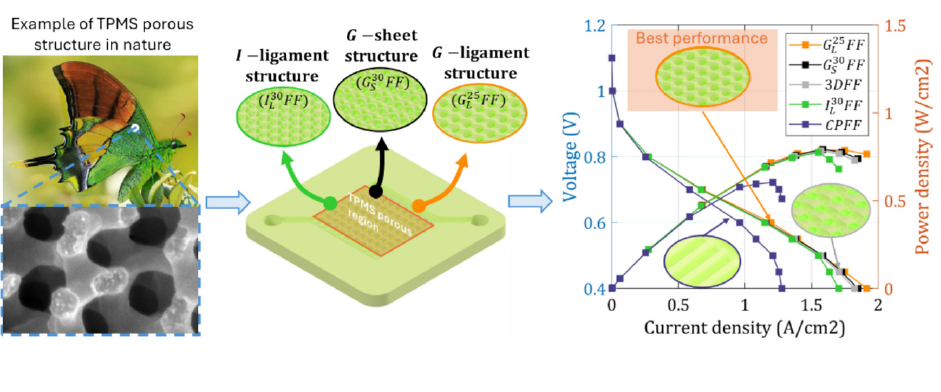| (2025.03) Natural TPMS porous architectures for flow-field patterns to improve mass transport in high current density operations of proton exchange membrane fuel cells | |||||
| 작성자 | 관리자 | 작성일 | 2025-06-12 | 조회수 | 43 |
|---|---|---|---|---|---|
|
· 논문명 : Natural TPMS porous architectures for flow-field patterns to improve mass transport in high current density operations of proton exchange membrane fuel cells · 저 자 : Phuc Ho-Van, Ocktaeck Lim* · 게재지 : Applied Energy (2025, 381, 125126) · 초록 Extending the ability to work at high current densities in proton-exchange membrane fuel cells (PEMFCs) is imperative for widespread adoption. Notably, multiple studies point to developing suitable flow-field patterns to mitigate mass- limited losses, yet there is no flow field that can effectively address the dual challenges of water flooding and fuel starvation in these operating conditions. In this study, we introduced a novel approach by integrating nature-inspired triply periodic minimal surface-based (TPMS) porous architectures into the PEMFC flow field. Our numerical results suggest that the G-ligament network (G25L-FF) is the most promising solution. Periodic, non-tortuous pores effectively guide airflow toward gas diffusion layer (GDL), making G25L-FF achieve the lowest pressure drop among the proposed flow fields. MATLAB-based image processing reveals that G25L-FF keeps O2 evenly distributed, leading to a current density of 1.91 A/cm2 at a cell voltage of 0.4 V - 5 % greater than the state-of-the-art 3D fine-mesh flow field (3DFF) based on Toyota Mirai. An almost linear relationship in the polarization curve with no decline in the power density was also observed. Additionally, the G25L-FF shown the lowest water content in both vapor and liquid phases within the porous media but still achieved optimal membrane hydration, demonstrating its capability to prevent both drying and flooding. On the other hand, the I-ligament network improved reactant distribution uniformity over conventional parallel flow field (CPFF) due to its smaller local rib area, leading to an 8–15 % increase in current density in the ohmic loss region. Although it falls short in supporting forced convective gas penetration into the GDL, resulting in a current density of 1.7 A/cm2 against 1.82 A/cm2 for 3DFF, it nevertheless increased peak power density by 18 % over CPFF. Our findings provide initial insight into the outstanding performance of the G-ligament network, confirming its potentialto address mass-transport limitation, thereby extending the operational range of PEMFCs at high current densities and providing a new direction for next-generation flow-field designs.
|
|||||


